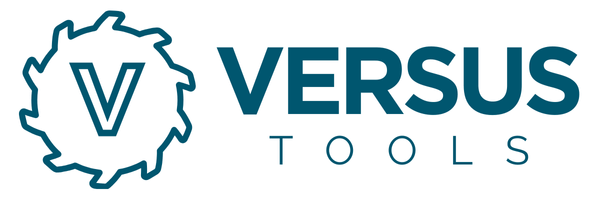Which laser level should you choose?
Find out which laser level really fits your projects, from simple indoor setups to demanding outdoor jobs.
Article updated on 09/10/2025
The laser level has become an essential tool for carrying out precise work. Whether it’s building drywall partitions, laying tile, installing a drop ceiling, or aligning outdoor elements, it saves time while ensuring a perfectly straight result.
Top 3 laser levels 2025
Our quick picks to help you get started right away.
Versatile
Bosch UniversalLevel 360 Green
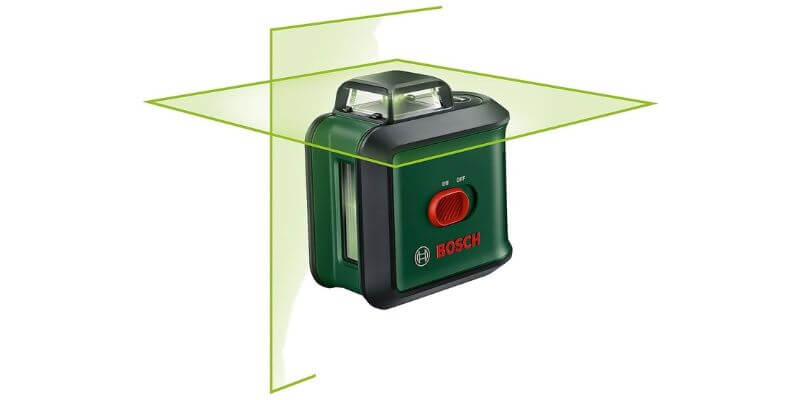
- 360° laser – continuous line across 4 walls
- Brighter green beam for better visibility
- Accuracy ±0.4 mm/m · Range 24–30 m
~$170
Durable
DeWalt DW088K
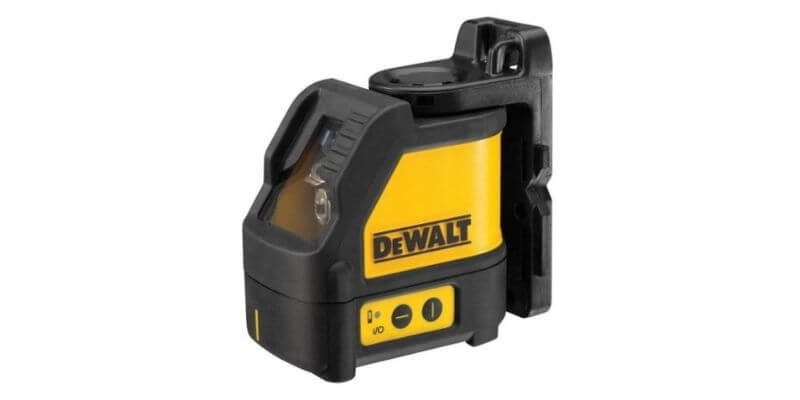
- Compact & precise cross-line laser
- Range 15 m (50 m with receiver)
- Accuracy ±0.3 mm/m · IP54 housing
~$140
Best Value
Huepar 603CG (3×360°)
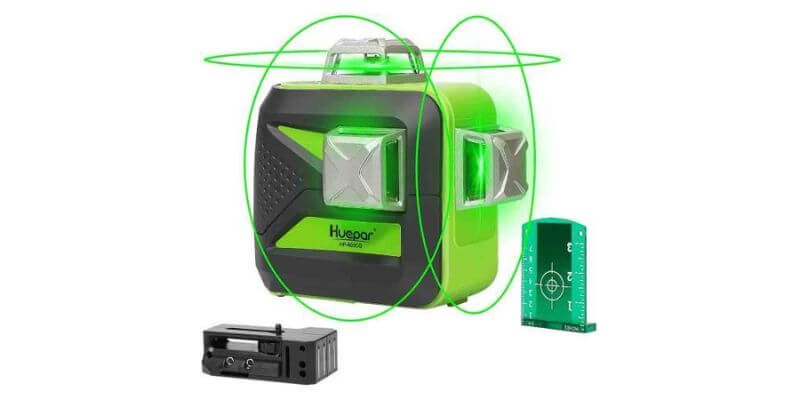
- 3×360° coverage (floor, wall, ceiling)
- Range 20–30 m (60 m with receiver)
- Accuracy ±0.3 mm/m · Accessories included
~$150
In Short
A laser level lets you work faster and more accurately than a traditional bubble level.
- Cross-line laser: for small indoor jobs (tiling, décor).
- 360° laser: ideal for drywall and drop ceilings.
- Rotary laser: recommended for grading and outdoor projects.
- Budget: from $50 (entry-level) to $400+ (professional rotary), depending on use.
Why use a laser level?
Accuracy and speed compared to a bubble level
A laser level offers far greater accuracy than a traditional bubble level. It projects straight lines across several meters, allowing you to check alignment at a glance. Thanks to its self-leveling system, setup is faster and adjustment errors are avoided. For DIYers, it’s a reliable way to save time and achieve consistent results.
Common applications: drywall, tiling, ceilings, grading, outdoor alignment
The laser level is highly versatile and proves useful in many projects:
- Drywall: marking and fixing metal studs with precision.
- Tiling: ensuring perfectly straight lines on floors and walls.
- Ceilings: creating a uniform reference for installing drop ceilings or light fixtures.
- Grading: checking flatness and controlling slopes on terrain.
- Outdoor alignment: setting up a fence, garden shed, or patio without misalignment.
Drywall & Ceilings
Bosch GLL3-80CG
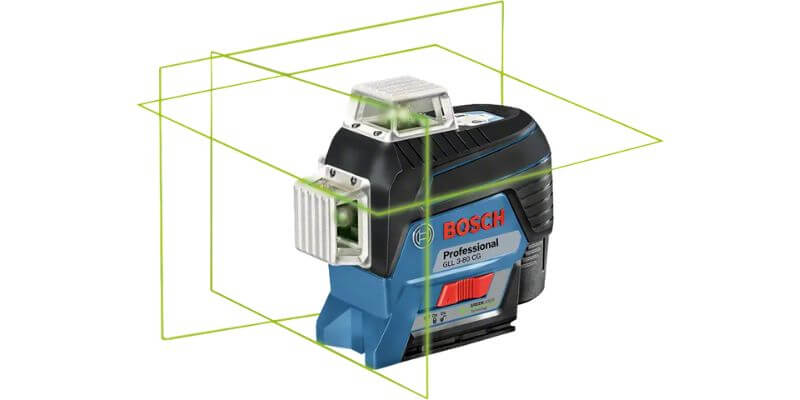
- 3 × 360° planes – full coverage
- High-visibility green beam
- Accuracy ±0.2 mm/m · Range 120 m
~$450
Tiling & Interior Projects
Bosch GLL50-20G (Green)
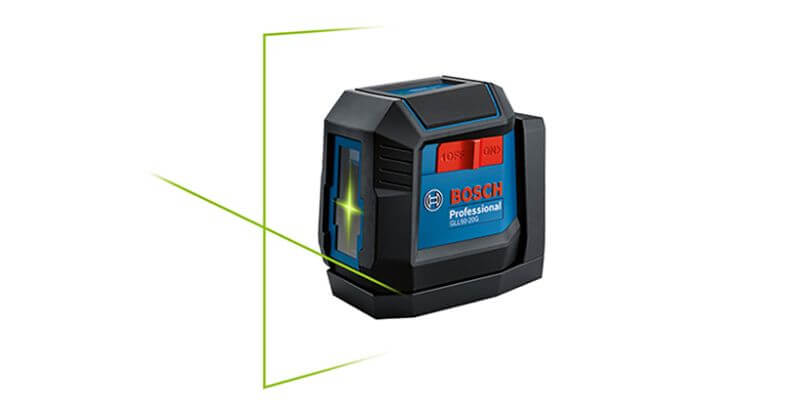
- Bright green cross-line laser
- Fast and reliable self-leveling
- Perfect for tiling and interior décor
~$140
Grading & Large Outdoor Projects
Topcon RL-H5A
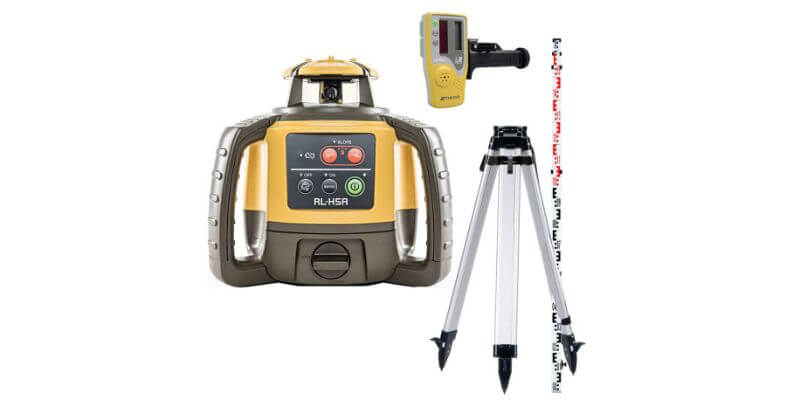
- Massive range: up to 800 m
- Accuracy ±1/16″ at 30 m
- Rugged IP66 · 100 h runtime
~$850
General pros and cons of laser levels
Pros
- Speed: instant setup and quick marking thanks to self-leveling.
- Accuracy: projects straight lines across several meters with minimal margin of error.
- Ease of use: no more repetitive measurements or pencil marks.
- Versatility: suitable for drywall, tiling, ceilings, outdoor alignment, and grading.
Cons
- Higher cost compared to a traditional bubble level.
- Limited battery life: requires disposable or rechargeable batteries.
- Reduced visibility in sunlight without a receiver, especially with a red beam.
The different types of laser levels
Line laser level (cross-line, 2-line, 3-line)
A line laser level projects a cross (horizontal and vertical) or multiple lines depending on the model. It’s perfect for indoor projects such as installing shelves, laying wall tiles, or assembling furniture. Easy to use and affordable, it remains the go-to choice for DIY enthusiasts.
360° laser level (ideal for drywall and ceilings)
A 360° laser level projects one or more lines all around the room. It provides a continuous reference on every wall, ideal for installing drywall tracks, setting up drop ceilings, or aligning hangers. This type saves valuable time since there’s no need to move the device at each step.
Rotary laser level (for outdoor and large-scale projects)
A rotary laser level uses a rapidly rotating beam to create a full 360° plane. With a much longer range than other models, it’s the tool of choice for grading, masonry, and large outdoor alignments. More expensive and usually supplied with a detector, it’s mainly intended for major construction sites.
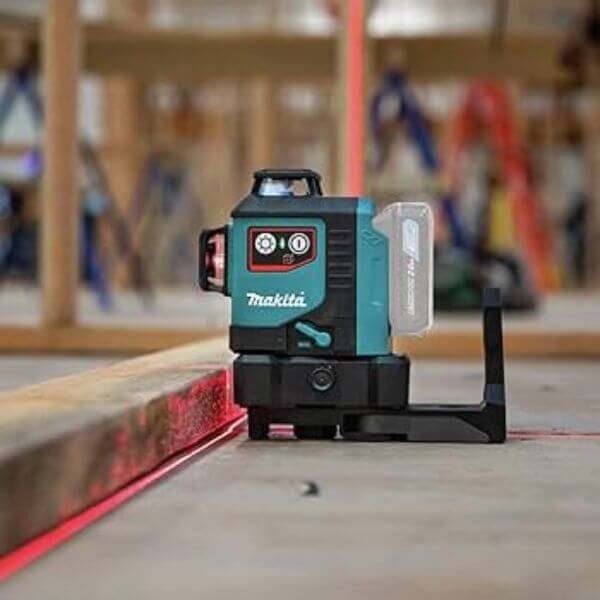
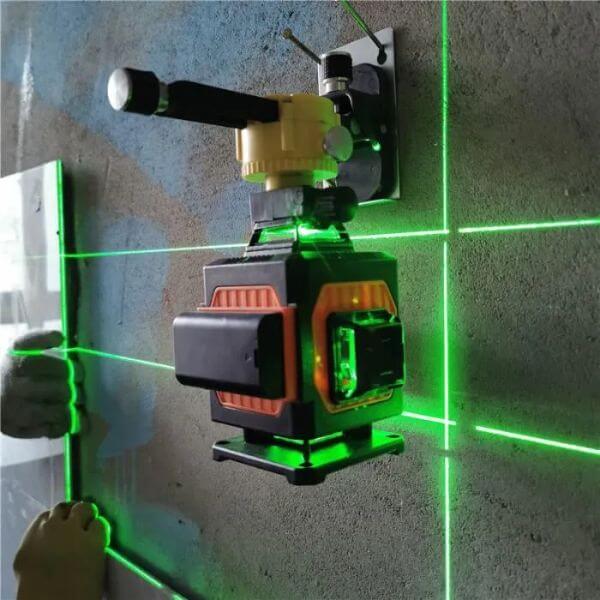
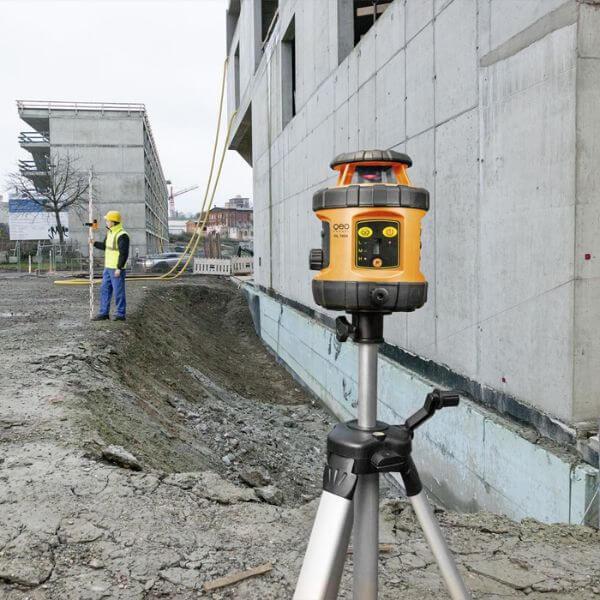
Quick comparison of laser level types
Type of Laser
Main Uses
Advantages
Disadvantages
Which laser level should you choose for your projects?
For drywall and ceilings → 360° laser
A 360° laser is particularly well-suited for installing partitions and drop ceilings. It projects a continuous line all around the room, making it easier to set up tracks and hangers. A green-beam model also provides better visibility in bright environments.
For tiling and interior projects → line/cross-line laser
For laying floor or wall tiles, a cross-line laser is usually sufficient. It provides precise reference lines and prevents misalignment. Models with 2 or 3 lines add extra convenience by covering multiple axes, especially useful in corner rooms or for certain decorative tasks.
For grading and large outdoor projects → rotary laser
When leveling land, installing a long fence, or laying foundations, a rotary laser is the ideal tool. Its extended range, often several dozen meters, combined with a detector ensures reliable accuracy, even in direct sunlight.
For versatile use (casual DIY → professional) → budget tips
- Occasional DIYer: a basic cross-line laser ($50–100) is enough for small decorating and alignment tasks.
- Regular hobbyist: a 360° laser ($120–200) is a good compromise for larger renovation projects, such as drywall or tiling.
- Demanding user or semi-pro: a professional model ($200–400) with a green beam, long range, and accessories (tripod, magnetic mount) offers both comfort and durability.
- Outdoor construction: expect to budget over $400 for a reliable rotary laser, or consider renting one for occasional use.
Key selection criteria
Accuracy and range
The accuracy of a laser level is expressed in millimeters per meter (mm/m). For DIY use, an accuracy between ±0.3 and ±0.8 mm/m is generally sufficient.
The range depends on the type of laser:
- Cross-line laser: 10 to 15 m indoors.
- 360° laser: up to 30 m indoors.
- Rotary laser: several dozen meters, exceeding 100 m with a detector.
Red beam or green beam: what’s the difference?
- Red laser: more affordable and energy-efficient, perfectly suitable for most indoor projects. Its visibility is more limited in bright light, but it remains a reliable choice for home and occasional use.
- Green laser: about four times more visible to the naked eye, making it ideal for bright rooms or light outdoor use. However, it’s more expensive and drains the battery faster.
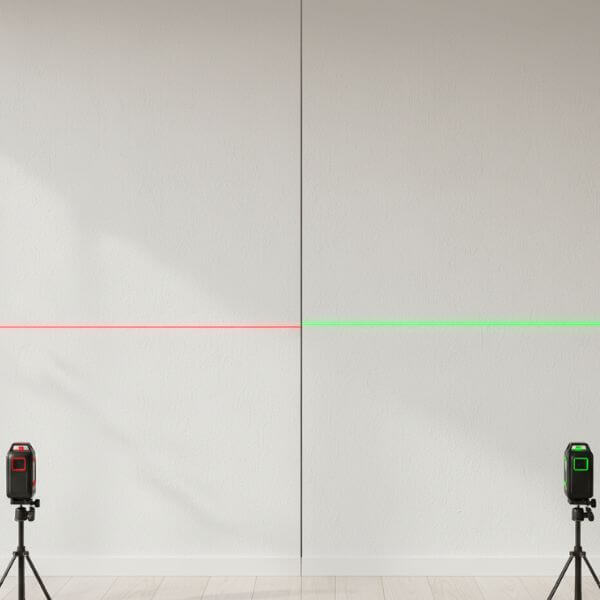
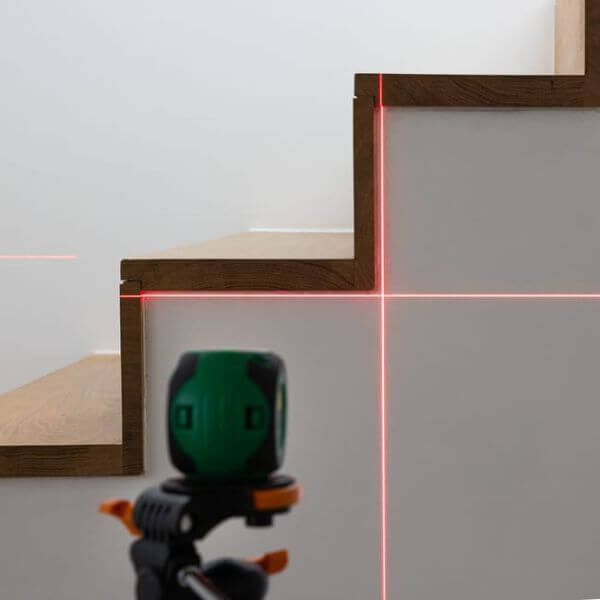
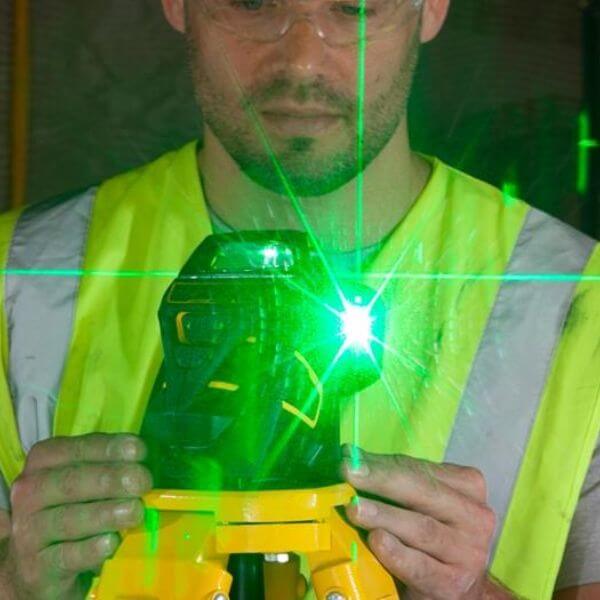
For mostly indoor use, a red laser is more than enough. For greater visual comfort or added versatility, it’s better to choose a green laser.
Budget red option
Parkside® PKLL 7 E4
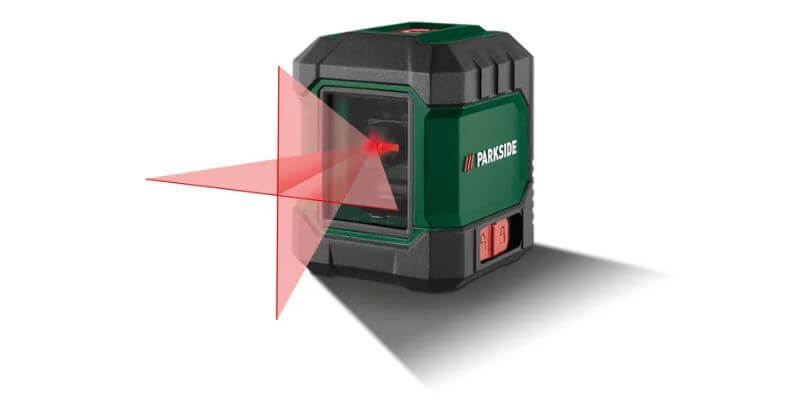
- Entry-level model for small projects
- Simple setup, self-leveling
- Ideal for shelves, picture frames, backsplashes
~$25
High-visibility green option
Makita SK106GDZ (vert)
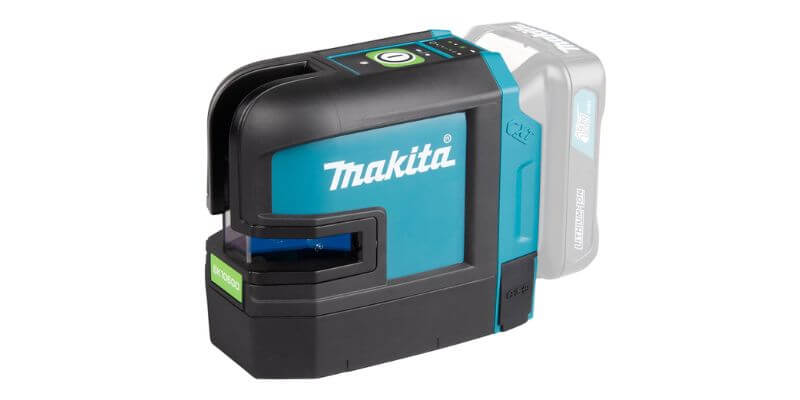
- Green beam, easy on the eyes
- Compact design, indoor use
- Compatible with the Makita battery line
~$399
Battery life and power supply (batteries, rechargeable packs)
- AA/AAA batteries: convenient and inexpensive, but require frequent replacements.
- Rechargeable lithium-ion batteries: provide longer runtime (up to 8–12 hours) and usually come with a charger.
- Interchangeable batteries: allow uninterrupted work, ideal for heavy-duty job sites.
Durability (IP rating, dust, water protection)
An IP54 rating or higher ensures solid resistance to dust and water splashes. Models designed for construction sites are also reinforced against shocks, with some able to withstand a 1-meter drop.
Essential accessories (tripod, magnetic mount, target)
- Tripod: stabilizes the device and makes it easier to adjust height precisely.
- Magnetic mount: useful for attaching the laser to metal studs when installing drywall.
- Laser target plate: improves beam visibility at longer distances.
- Tinted glasses: enhance beam perception, especially for red-laser models.
VEVOR laser level tripod
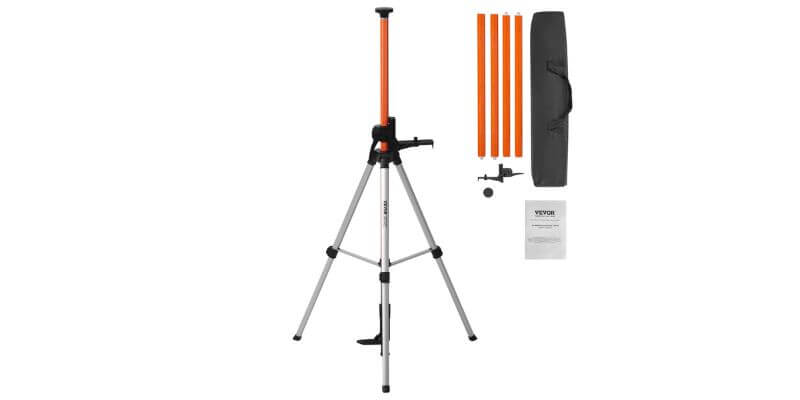
Sturdy, adjustable tripod, compatible with 1/4″-20 and 5/8″-11, with built-in bubble level.
~$55
METRICA – Magnetic mount for laser level
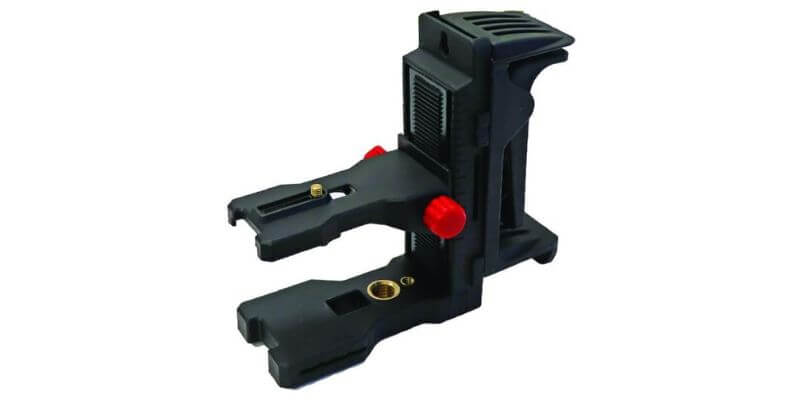
Practical attachment to drywall studs or walls, ideal for holding a self-leveling laser.
~$82
Bavooty – Magnetic target plate (set of 2, green)
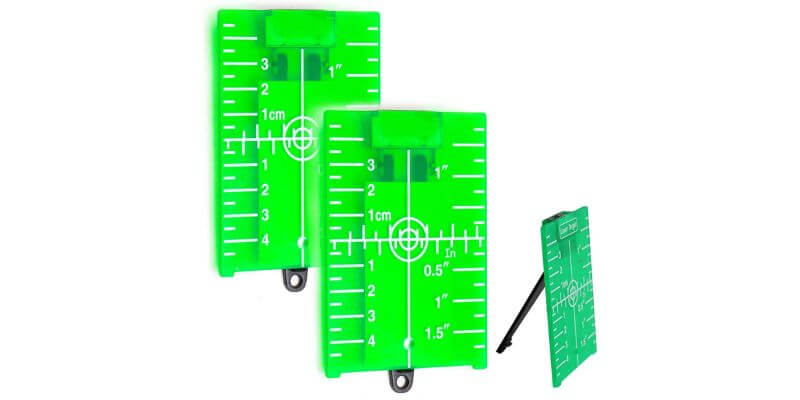
Enhances laser line visibility, with integrated scale and convenient magnetic attachment.
~$8
Pre-purchase checklist
- Type of work: small indoor projects, drywall, ceilings, tiling, light outdoor use, or grading.
- Required range: adjust based on room size or outdoor distance to cover.
- Red or green beam: red for budget-friendly indoor use, green for better visibility in bright light.
- Included accessories: tripod, magnetic mount, target plate, or glasses for added comfort and precision.
Comparison of the best laser levels 2025
Model
Type
Beam
Range
Accuracy
Recommended Use
Approx. Price
Most reliable brands
- Bosch: a benchmark for both consumers and professionals, with a wide range from compact models (Quigo, UniversalLevel) to pro series (GLL, GCL). Known for reliability and precision.
- DeWalt: valued for the durability of its devices, especially on job sites. The DW088K remains a standard for contractors and frequent DIYers.
- Makita: offers sturdy laser levels compatible with its 12V and 18V batteries, a real advantage for those already using the brand’s tools.
- Huepar: very popular on Amazon, the brand provides 360° and multi-line lasers with a good price-to-performance ratio, an appealing option for demanding DIYers who don’t need top-of-the-line.
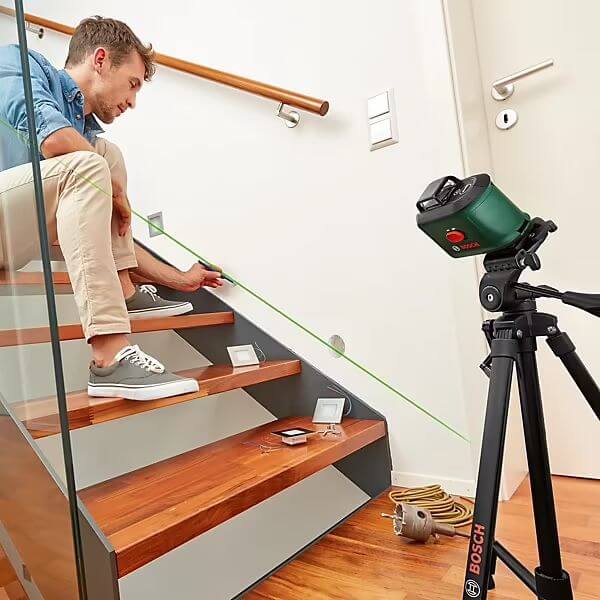
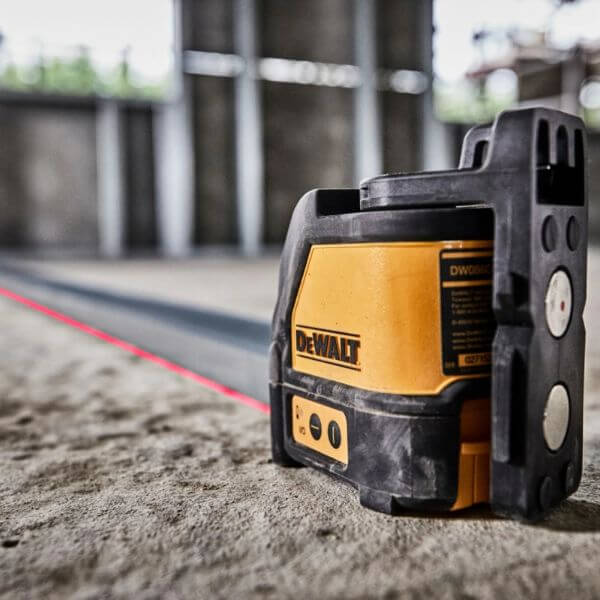
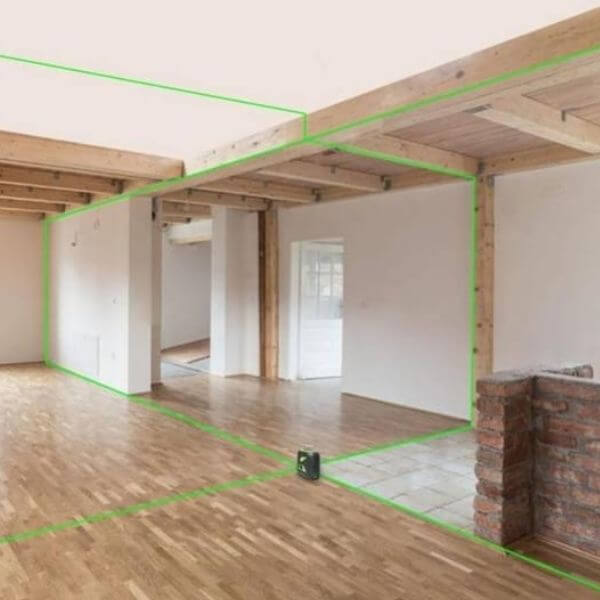
Laser level prices: what budget should you plan?
- Entry-level ($40–100): simple cross-line models, suitable for small indoor projects like installing shelves, picture frames, or wall tiling.
- Mid-range ($120–200): 360° or multi-line levels, more versatile for full renovations, drywall, or drop ceilings.
- High-end ($200–400): durable devices, often with a green beam, offering longer range and included accessories. Recommended for demanding DIYers or semi-professional use.
- Rotary ($400 and up): designed for outdoor sites and grading. Their extended range and precision justify the investment.
For a casual DIYer, a budget of around $150 is already enough to get a reliable, accurate laser level suited to most projects.
Entry-level
Stanley Cubix Green
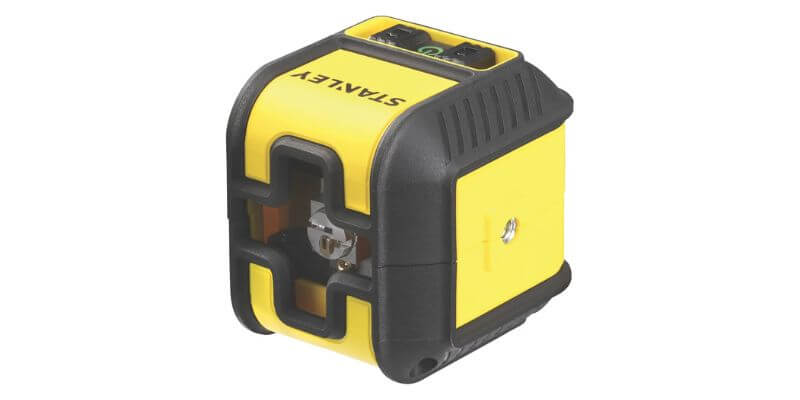
- Cross-line laser for small projects
- Quick setup, compact design
- Range approx. 12 m (indoors)
~$60
Mid-range
Huepar 603CG (3×360°)

- 3×360°: floor, walls, ceiling
- Accessories included · great value for money
- Range 20–30 m (60 m with receiver)
~$150
High-end
Makita SK106GDZ

- High-visibility green beam
- Rugged build · heavy-duty use
- Tool only, compatible with Makita battery line
~$399
FAQ
Which laser level should I choose for installing a drywall ceiling?
A 360° laser is the most suitable. It projects a continuous line all around the room, making it easy to mark a uniform level for fixing tracks and installing hangers.
What’s the difference between a 360° laser and a rotary laser?
- A 360° laser projects one or more fixed lines all around the room, making it ideal for indoor projects.
- A rotary laser, on the other hand, uses a rapidly rotating point to generate a full plane. Its much longer range makes it the tool of choice for grading and large outdoor construction sites.
Can a laser level be used outdoors?
Beam visibility is limited in direct sunlight. A green laser provides better readability. Beyond 15–20 meters, using a receiver becomes essential for accurate work.
Do you need a tripod to use a laser level?
A tripod isn’t strictly necessary, but it makes setup much easier. It allows you to adjust the height and ensures solid stability, especially useful with 360° and rotary lasers.
What’s the average price of a reliable laser level?
- Entry-level (occasional use): $40–100
- Mid-range (regular use): $120–200
- Professional range: $200–400 and up
- For a casual DIYer, a budget of around $150 is already enough to get a reliable and versatile model.
Conclusion
The choice of a laser level mainly depends on the type of work to be done:
- Cross-line laser: perfect for small indoor projects like tiling or decorating.
- 360° laser: essential for drywall, drop ceilings, and full renovations.
- Rotary laser: best suited for large outdoor projects and grading.
Before buying, compare models based on your intended use, indoor, outdoor, drywall, tiling… You’ll gain precision, speed, and comfort in your projects.

About the Author
Article written by Quentin François, a DIY enthusiast for the past 10 years and author of practical guides tested in the workshop.
Glossary
Self-leveling
A function that allows the laser level to automatically align horizontally or vertically. Eliminates manual adjustments and reduces measurement errors.
Red beam
The most common and affordable type of laser. Suitable for simple indoor work, but its visibility is limited in bright light.
Green beam
About four times more visible to the naked eye than a red beam. Ideal for bright environments or light outdoor use. More expensive and consumes more battery.
IP54
Protection rating ensuring the device is resistant to dust and water splashes. Recommended for use on job sites.
Cross-line laser
A laser level that projects two lines (horizontal and vertical). Very practical for tiling, aligning frames, or small indoor projects.
360° laser
Projects a continuous horizontal line all around the room. Particularly suited for drywall installation, drop ceilings, and full renovations.
Rotary laser
A tool designed for outdoor worksites. Its 360° rotating beam covers long distances, ideal for grading, foundations, or fence installation.
Range with receiver
Maximum distance at which a laser remains visible using an electronic detector. Essential for rotary models used outdoors.
Accuracy (mm/m)
Indicates the margin of error of the laser. The lower the number, the more precise the line. Example: ±0.3 mm/m.
Tripod 1/4"-20 or 5/8"-11
Standard thread sizes used to mount a laser level on a tripod. The tripod improves stability and makes height adjustments easier.
Transparency: This article contains affiliate links. If you purchase a product through these links, we may earn a commission at no additional cost to you. This helps us maintain this website and produce high-quality content. We only recommend products we consider reliable and relevant.
